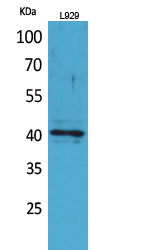CKR-3 Polyclonal Antibody
- Catalog No.:YT5289
- Applications:WB;IHC;IF;ELISA
- Reactivity:Human;Rat;Mouse;
- Target:
- CKR-3
- Fields:
- >>Cytokine-cytokine receptor interaction;>>Viral protein interaction with cytokine and cytokine receptor;>>Chemokine signaling pathway;>>Human cytomegalovirus infection;>>Kaposi sarcoma-associated herpesvirus infection;>>Viral carcinogenesis
- Gene Name:
- CCR3
- Protein Name:
- C-C chemokine receptor type 3
- Human Gene Id:
- 1232
- Human Swiss Prot No:
- P51677
- Mouse Gene Id:
- 12771
- Mouse Swiss Prot No:
- P51678
- Rat Gene Id:
- 117027
- Rat Swiss Prot No:
- O54814
- Immunogen:
- The antiserum was produced against synthesized peptide derived from the N-terminal region of human CCR3. AA range:1-50
- Specificity:
- CKR-3 Polyclonal Antibody detects endogenous levels of CKR-3 protein.
- Formulation:
- Liquid in PBS containing 50% glycerol, 0.5% BSA and 0.02% sodium azide.
- Source:
- Polyclonal, Rabbit,IgG
- Dilution:
- WB 1:500 - 1:2000. IHC: 1:100-300 ELISA: 1:20000.. IF 1:50-200
- Purification:
- The antibody was affinity-purified from rabbit antiserum by affinity-chromatography using epitope-specific immunogen.
- Concentration:
- 1 mg/ml
- Storage Stability:
- -15°C to -25°C/1 year(Do not lower than -25°C)
- Other Name:
- CCR3;CMKBR3;C-C chemokine receptor type 3;C-C CKR-3;CC-CKR-3;CCR-3;CCR3;CKR3;Eosinophil eotaxin receptor;CD193
- Observed Band(KD):
- 41kD
- Background:
- The protein encoded by this gene is a receptor for C-C type chemokines. It belongs to family 1 of the G protein-coupled receptors. This receptor binds and responds to a variety of chemokines, including eotaxin (CCL11), eotaxin-3 (CCL26), MCP-3 (CCL7), MCP-4 (CCL13), and RANTES (CCL5). It is highly expressed in eosinophils and basophils, and is also detected in TH1 and TH2 cells, as well as in airway epithelial cells. This receptor may contribute to the accumulation and activation of eosinophils and other inflammatory cells in the allergic airway. It is also known to be an entry co-receptor for HIV-1. This gene and seven other chemokine receptor genes form a chemokine receptor gene cluster on the chromosomal region 3p21. Alternatively spliced transcript variants have been described. [provided by RefSeq, Sep 2009],
- Function:
- function:Receptor for a C-C type chemokine. Binds to eotaxin, eotaxin-3, MCP-3, MCP-4, RANTES and MIP-1 delta. Subsequently transduces a signal by increasing the intracellular calcium ions level. Alternative coreceptor with CD4 for HIV-1 infection.,online information:CC chemokine receptors entry,similarity:Belongs to the G-protein coupled receptor 1 family.,subunit:Binds to HIV-1 Tat.,tissue specificity:In eosinophils as well as trace amounts in neutrophils and monocytes.,
- Subcellular Location:
- Cell membrane; Multi-pass membrane protein .
- Expression:
- In eosinophils as well as trace amounts in neutrophils and monocytes.
- June 19-2018
- WESTERN IMMUNOBLOTTING PROTOCOL
- June 19-2018
- IMMUNOHISTOCHEMISTRY-PARAFFIN PROTOCOL
- June 19-2018
- IMMUNOFLUORESCENCE PROTOCOL
- September 08-2020
- FLOW-CYTOMEYRT-PROTOCOL
- May 20-2022
- Cell-Based ELISA│解您多样本WB检测之困扰
- July 13-2018
- CELL-BASED-ELISA-PROTOCOL-FOR-ACETYL-PROTEIN
- July 13-2018
- CELL-BASED-ELISA-PROTOCOL-FOR-PHOSPHO-PROTEIN
- July 13-2018
- Antibody-FAQs
- Products Images

- Western Blot analysis of L929 cells using CKR-3 Polyclonal Antibody. Secondary antibody(catalog#:RS0002) was diluted at 1:20000

- Immunohistochemical analysis of paraffin-embedded human-liver, antibody was diluted at 1:100

- Western blot analysis of lysate from L929 cells, using CCR3 Antibody.



